Canon IIA, IID, IID1 Rangefinder Cameras 1952-1955
A Description of three new Canon models introduced in 1952
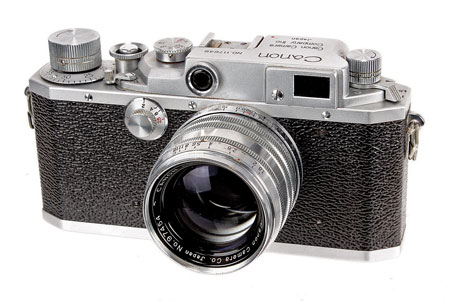
Canon IID of 1952
A Popular New Camera of 1952
In August, 1952, Canon introduced a camera designed to be economical - the place in their range originally intended for the short-lived Canon IIC. This was the Canon IID.
Canon IID
The Canon IID of 1952 was a more economical version of the Canon IIIA which had been introduced the previous year. The Canon IID had a top speed of 1/500 second unlike the 1/1000 second of the Canon IIIA. Also, the Canon IIIA had a film speed reminder on the winding know, whereas the Canon IID had none. These were the only changes from the Canon IIIA, and like the IIIA, the IID had the improved shutter and the revised universal lens mount which finally was exactly compatible with the Leica M39 lens mount.
The differences represented by these two features was apparently not important to many photographers: the lack of the 1/1000 second top shutter speed, and lack of a film speed reminder on the top of the film winder knob.
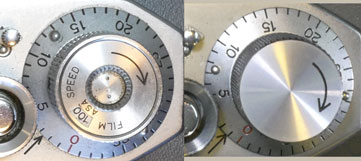
Canon IIIA film winder knob with film speed reminder compared with Canon IID plain knob
What seems to have been more important to photographers was a lower price. The IID with a Canon 50mm f1.8 lens sold for 56,000 yen in 1952 compared with 70,000 yen for the IIIA with the same lens. And the commonly sold IID version with a 50mm f2.8 Canon lens was priced at only 46,000 yen, one-third less expensive than the IIIA. And in this period, which coincided with the war in Korea, a large number of thise cameras were sold at the Post Exchange to the numerous American soldiers in Japan and Korea where price was important.
Success of the Canon IID
The Canon IID continued to be sold in 1952, 1953 and 1954 selling 21,725 units according to Peter Dechert 1. This impressive sales volume resulted in Canon ending the sale of the Canon IIIA in 1953 with only about 9,000 units sold. It would seem that the attraction of 1/1000 second shutter speed was not sufficient to compensate for the IIIA price +25% to +33% higher than the IID. The IID therefore became the leading low-cost Canon of 1953 and 1954.
Canon IID1
Peter Dechert in his definitive book "Canon Rangefinder Cameras 1933-68" 1 gives a separate description of what he terms the Canon IID1. It seems Canon also kept separate track of the Canon IID1. What is somewhat surprising about this is the only difference between the Canon IID and IID1 is the inclusion of a film speed reminder on top of the film wind knob - not a very important 'improvement' it would seem. Perhaps camera collectors who seek complete collections should not be preoccupied to collect the Canon IID1, since is quite simple to take the plentiful Canon IID and fit it with a film speed reminder knob.
The Canon IID1 is said to have sold 2,400 units in 1952, 1953 and 1954, but distribution ended prior to the end of Canon IID sales.
The photograph below is from the Canon Museum 4 in which they refer to this model as the "Canon IID1"

Canon IID1 of 1953 with solid finder lever
Canon IIA
Jardine, Matheson & Co., a famous Hong Kong trading house contracted with Canon several times to supply cameras to Jardine's specifications. 1 One of these is the camera designated the Canon IIA in 1952. In this camera, Jardine has specified the elimination of the slow speed dial. The shutter speed dial reads simply '25' rather than '25-1'. In other respects it is identical to the Canon III.
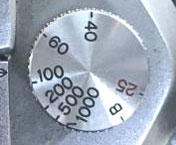
Canon IIA speed dial
The slow speed shutter hole was covered by a circular metal patch which was attached using the three screw holes of the camera body intended for the slow speed mechanism. The circular metal patch is then covered with a piece of camera body covering material.
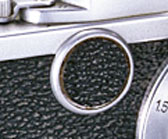
Dechert further recounts that Jardine's failed to accept full deliveries of their camera order, so that Canon then sold some IIA models to the military Post Exchange system. In any case, the Canon IIA is a scarce model, estimated to have sold only 99 units. 1
A related model released one year later in summmer 1953 was the Canon IIAF with flash synchronization. This model is somewhat interesting due to its unique characteristics and also its rarity. You can read about this camera by clicking on the link below.
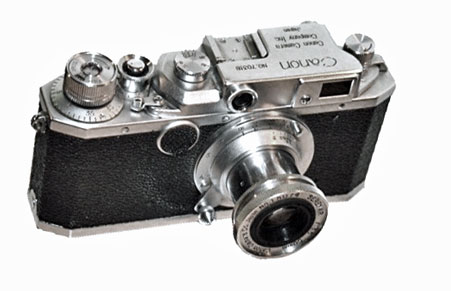
the rare Canon IIA
You can click on the links in the table below to consult other pages of the canonrangfinder.org site.
| Navigation: Click Below to Jump to Desired Subject Page | ||
|---|---|---|
| Canon Rangefinder Cameras - 1 | Canon Rangefinder Cameras - 2 | Canon Rangefinder Lenses |
| Canon Hansa | Canon IIAF, IIAX | Development Nikkor 50mm |
| Canon S | Canon IVSB2 | Canon 19mm |
| Canon J | Canon IIS2, IID2, IIF2 | Canon 25mm |
| Canon NS | Canon VT, Canon L2 | Canon 28mm |
| Canon JS | Canon L1, L3 | Canon 35mm |
| Canon S-I | Canon VT Deluxe | Canon 50mm |
| Canon J-II | Canon VL, VL2 | Canon 85mm |
| Canon S-II | Canon VI-L, VI-T | Canon 100mm |
| Canon IIB | Canon P | Canon 135mm |
| Canon III, IIC, IV | Canon 7 | Canon 200mm-1000mm |
| Canon IIIA, IVF, IVS | Canon 7s | Canon Accessories |
| Canon IIA, IID, IID1 | Nicca Rangefinders | Canon Finders |
| Canon IVSB | Minolta Rangefinders | Minolta Lenses |
| Canon IIF, IIS | Other Rangefinders | other M39 lenses |
| Go to canonrangefinder.com home page | ||
Any additions or corrections to these pages would be welcome simply by contacting this site as shown at the foot of this page .
Footnotes:
1 Dechert, Peter. Canon Rangefinder Cameras 1933-1968. Hove Collectors Books. West Sussex, United Kingdom. 1985. ISBN 0-906447-30-5.
Peter Dechert's book is the most important expert source of information regarding Canon Rangefinder Cameras.
2 Kitchingman, Peter. Canon M39 Rangefinder Lenses 1939-1971. A Collector's Guide. Published by Peter Kitchingman. Perth, Australia. 2008. ISBN 978-0-646-48144-9.
Peter Kitchingman's book is the definitive study of the more than three decades of M39 format camera lenses developed for Canon Rangefinder Cameras.
3 Nostalgic Canon Camera Book. 懐かしいキヤノン EI Publishing Co. Ltd. Tokyo, Japan. June 2003.
Peter Kitchingman's book is the definitive study of the more than three decades of M39 format camera lenses developed for Canon Rangefinder Cameras.
4 "Canon Camera Museum" history website. https://global.canon/en/c-museum/history/ published by Canon, Inc. accessed in 2019.
5 Rajner, Hans P. (author), John Wade (editor). Leica Copies. Classic Collections Publications. London, UK. ISBN 13: 9781874485056
Hans P. Rajner's book is an excellently detailed and carefully researched study of camera from around the world which used the Leica M39 lens mount and the same lens to film plane distance.
7 Dechert, Peter. Canon Single Lens Reflex Cameras 1959-1991. Historical Camera Publications. Yakima, Washington. 1992. ISBN 1-879561-04-2.
8 Tomlinson, Shawn M. The Film Photography Book. Lulu Pulbications. 2016. ISBN: 9781365263972
9 Sartorius., Ghester. Identifying Leica Lenses. Classic Camera 19. Tokyo, Japan. 2001. ISBN 4-257-12029-0
10 website http://www.nicovandijk.net/rflensmatrix.htm consulted 2019.
11 O'Reagan, Douglas M. Allied Exploitation of German Science after World War II. Johns Hopkins University Press. Baltimore, Maryland. 2019. ISBN 9781421428888
12 website www.canonrangefinder.servehttp.com consulted 2008.
13 Minolta expert Andrea Aprà has posted information on minoltarangefinders group and other groups and further detailed information by email. (thanks Andrea !)
14 website http://www.collection-appareils.fr/objectifs/ consulted 2019.
15 Small, Marc James. Non-Leitz Leica Thread-Mount Lenses. Wittig Books. Hückelhoven, Germany. 1997. ISBN 3-930359-47-2.
16 the Nikon Corporation website: https://imaging.nikon.com/history/ consulted 2019.
17 p 152. Ray, Sidney F. Photographic Lens ISBN 9780240510323
18 website http://www.rokkorfiles.com/Lens%20History.html accessed 2019
19 Katz, Jerome. The Kardon camera story: a dedication to Peter Kardon, great American patriot & pioneer. SJF Enterprises. New York, New York. 1977.
20 Baird, John. The Japaneese Camera. The History of the Japanese Camera Monograph Collection. Historical Camera Publications. Yakima, Washington. 1990. ISBN 1-879561-02-6.
21 interesting website http://www.topgabacho.jp/Topconclub/Leotax.htm accessed 2019
22 Alexander, Jeffrey Scott. Nikon and the sponsorship of Japan's optical industry by the Imperial Japanese Navy 1923-1945. MA Thesis. University of British Columbia. 2001.
23 Alexander, Jeffrey Scott. Nikon and the sponsorship of Japan's optical industry by the Imperial Japanese Navy 1923-1945. PhD Thesis. University of British Columbia. 2010.
If you have any comments or questions about this Canon Rangefinder site, please e-mail me (Larry Huffman) at e-mail address: [email protected]